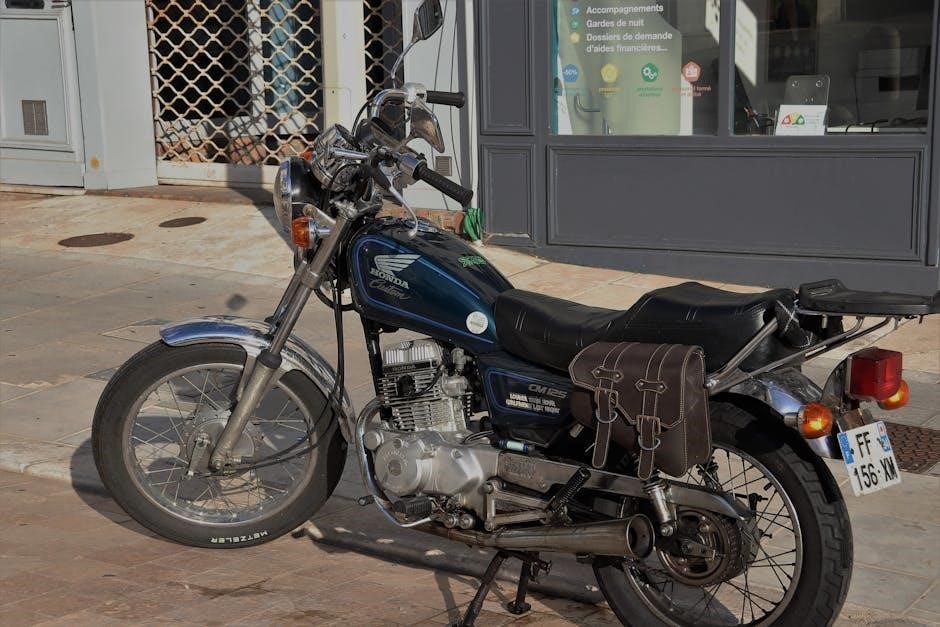Choosing the right bike size is crucial for comfort, performance, and safety. Frame size, measured in centimeters, varies by bike type and rider height. This guide helps you find the perfect fit by correlating your inseam, height, and bike type to ensure optimal cycling experience.
Why Bike Size Matters

Proper bike size ensures a comfortable and efficient riding experience. A bike that fits well maximizes performance, reduces fatigue, and minimizes the risk of injury. When a bike is too small or too large, it can lead to poor posture, muscle strain, and difficulty in controlling the bicycle. For example, a frame that is too tall can make it hard to mount or dismount safely, while one that is too short may cause an uncomfortable riding position. Additionally, incorrect sizing can affect the handling and stability of the bike, especially at higher speeds or on uneven terrain. Ensuring the right fit is essential for both recreational riders and competitive cyclists, as it directly impacts the overall quality of the ride.

Overview of Bike Sizing Systems
Bike sizing systems are designed to help riders find the perfect fit based on frame size, typically measured in centimeters. Most adult bikes range from 47cm to 63cm, with sizes corresponding to rider height and inseam. While some brands use universal sizing (XS, S, M, L, XL), others rely on precise centimeter measurements. For example, a 54cm frame is often recommended for riders around 170-175cm tall. Different bike types, such as road, mountain, or hybrid, may have slightly varied sizing standards. Additionally, wheel size and tire width can influence frame fit, especially for bikes like fat bikes or BMX models. By matching your height and inseam to the appropriate frame size, you ensure optimal comfort, efficiency, and control while riding.
Understanding Frame Size in Centimeters
Frame size in centimeters measures the bike’s seat tube length. Adult frames typically range from 47cm to 63cm, with sizes corresponding to rider height for optimal fit and comfort.
How Frame Size is Measured
Frame size is measured from the center of the bottom bracket to the top of the seat tube. This measurement is typically taken in centimeters and varies by bike type. For road bikes, sizes range from 47cm to 63cm, while mountain bikes often use similar scales. Accurate measurement ensures proper fit, as it directly affects standover clearance and riding comfort. To measure, place the bike on a level surface and use a tape measure or specialized tool. Ensure the measurement is precise, as even small differences can impact performance. Manufacturers may slightly vary in their sizing, so consulting the specific size chart for your bike type is essential for the best fit.
Standard Frame Sizes for Adults
Adult bike frames are typically sized in centimeters, ranging from 47cm to 63cm. These sizes correspond to rider heights, ensuring a proper fit. For road bikes, common sizes include 50cm, 52cm, 54cm, 56cm, 58cm, and 60cm. Mountain bikes follow a similar range but may have slight variations. Frame size directly impacts standover clearance and riding comfort. Riders with a height of 150-175cm often choose 47-53cm frames, while taller riders (185cm+) opt for 59-63cm. Always consult the manufacturer’s size chart, as minor differences exist between brands. Proper frame size ensures efficiency, control, and comfort, making it essential for an enjoyable cycling experience. Measuring inseam and height helps narrow down the ideal frame size for a perfect fit.
Frame Sizes for Children and Adolescents
Children’s bike frames are sized to accommodate growing riders, typically ranging from 20 to 26 inches in wheel size. For younger children (ages 6-9), frame sizes often range from 6-9 inches, while pre-teens (ages 9-13) use 9-13-inch frames. Adolescent riders (13-15 years) typically require frames sized between 20-22.7 inches, corresponding to heights of 150-175 cm. As teens grow taller (160-185 cm), frame sizes increase to 21-24.5 inches. These sizes ensure proper standover clearance and comfort. Always measure the child’s inseam and height to match the appropriate frame size, ensuring safety and comfort. Adjusting seatposts and handlebars can help customize the fit as the child grows, making the bike last longer. Proper sizing is essential for a safe and enjoyable riding experience.

Determining Your Rider Height and Inseam
Measure your height against a wall and record it. For inseam, stand against a wall with a book between your legs at groin height, then measure the distance from the floor to the top of the book. This ensures accurate sizing for bike frames and proper fit. Both measurements are crucial for selecting the correct bike size and ensuring comfort while riding. Always double-check measurements for accuracy to avoid sizing errors. Proper fit enhances riding efficiency and safety. Use these measurements to align with bike size charts for the best results. Accurate measurements ensure a better riding experience overall.
How to Measure Your Inseam
To measure your inseam, stand straight against a wall with your feet shoulder-width apart. Place a hardcover book snugly between your legs, pressing it firmly into your groin area to simulate a bike saddle. Use a tape measure or ruler to measure the distance from the floor to the top of the book. Record this measurement in centimeters. This process accurately reflects the inseam length needed for bike sizing charts. Ensure the book is held level and snug to avoid incorrect measurements. Wearing your usual cycling shoes during this process is recommended for precise results. Double-check your measurement for accuracy to ensure proper bike fit. This step is crucial for aligning your inseam with the correct frame size. Always maintain proper posture while measuring for consistent results. Accurate inseam measurement ensures optimal comfort and performance while riding. Regularly updating your measurements is advised, especially if your weight or body composition changes.
Correlating Height to Frame Size
Your height is a fundamental factor in determining the appropriate bike frame size. Most bike size charts categorize frame sizes in centimeters based on rider height ranges. For example, a rider measuring 160-170 cm typically fits a 50-52 cm frame, while someone taller, around 180-190 cm, would require a 58-60 cm frame. However, height alone isn’t the only consideration; inseam, standover height, and bike type also play crucial roles. Road bikes, mountain bikes, and hybrid bikes often have different sizing standards due to variations in frame geometry. Always consult a size chart specific to the bike type you’re interested in. Additionally, measuring your inseam and ensuring proper standover clearance (usually 2-4 cm) will help refine the fit. Testing the bike in person is recommended to confirm comfort and efficiency. This ensures the bike aligns with your body proportions for optimal performance. By combining height, inseam, and standover measurements, you can accurately match your body to the correct frame size. This comprehensive approach guarantees a comfortable and efficient riding experience. Regularly updating your measurements is essential, especially if your height or body composition changes over time. Professional bike fittings can also provide personalized adjustments for the best fit. Always prioritize comfort and efficiency when selecting your bike size to ensure an enjoyable riding experience. Proper sizing enhances both performance and safety, making every ride more enjoyable.

Bike Size Charts by Type
Bike size charts vary by type, such as road, mountain, hybrid, or BMX bikes. Each type offers specific size ranges in centimeters to suit different riding styles.
Road Bike Size Chart
Road bike size charts typically range from 47cm to 63cm, catering to various rider heights. These sizes correspond to the frame’s seat tube length in centimeters. For riders between 155cm and 170cm, a 50cm to 54cm frame is ideal, while taller riders (170cm-185cm) often prefer 55cm to 59cm frames. Shorter riders (under 155cm) may opt for 47cm to 49cm frames. The chart aligns inseam measurements with frame sizes, ensuring proper standover clearance and a comfortable riding position. Road bikes emphasize efficiency, so precise sizing is crucial for optimal performance and comfort during long rides. Always consult a size chart specific to the manufacturer and test ride if possible for the best fit.
Mountain Bike Size Chart
Mountain bike size charts typically range from 13″ to 23″ frames, designed to fit riders of various heights and inseam lengths. For example, a 15″ frame suits shorter riders (5’0″-5’4″), while a 19″ frame is ideal for taller riders (5’8″-6’1″). The size corresponds to the frame’s seat tube length, ensuring proper standover clearance and a comfortable riding position. Mountain bikes often feature different wheel sizes (27.5″, 29″, or 650b), which can affect frame sizing and fit. Always measure your inseam and consult the manufacturer’s size chart to find the best fit. Test rides are recommended to ensure optimal comfort and handling on various terrains.
Hybrid and Commuter Bike Size Chart
Hybrid and commuter bikes offer versatile sizing to accommodate a wide range of riders. Frame sizes typically range from 16″ to 22″, with 16″-18″ suits shorter riders (5’0″-5’6″), while 20″-22″ frames are designed for taller riders (5’8″-6’2″). These bikes often use 700c wheels, providing a balance of speed and stability. Standover height and seatpost adjustability are key for comfort and practicality. When choosing a size, consider your height, inseam, and riding style. Always consult the manufacturer’s size chart and test ride if possible to ensure the best fit. Proper sizing ensures efficiency, comfort, and control, making your daily commute or casual ride enjoyable and stress-free.
BMX and Dirt Jump Bike Size Chart
BMX and dirt jump bikes are sized differently, typically ranging from 12″ to 22″ in frame size, which converts to approximately 30.5 cm to 55.9 cm. These bikes are designed for tricks, stunts, and off-road riding, with smaller frames (30.5 cm-35.5 cm) suitable for shorter riders (around 4’0″-4’6″) and larger frames (40.6 cm-53.3 cm) for taller riders (5’0″-5’8″). The standard wheel size is 20″, with some dirt jump bikes featuring 24″ wheels for added stability. Standover height is crucial for BMX bikes to allow for tricks and maneuvers. Handlebar width and style also vary to suit rider preference and riding style. Always consult the manufacturer’s size chart and test ride if possible to ensure the best fit for your height and riding needs.
Wheel Size and Its Impact on Bike Fit
Wheel size significantly affects bike fit, with common sizes ranging from 20″ to 29″. Larger wheels provide stability and speed, while smaller wheels enhance maneuverability. Proper sizing ensures optimal frame height and standover clearance, aligning with rider height for comfort and control.
Common Wheel Sizes and Their Applications
Common bike wheel sizes include 26″, 27.5″, 29″, and 700c. Road bikes typically use 700c (28-29″) for speed and efficiency. Mountain bikes often feature 27.5″ or 29″ wheels for better obstacle roll-over and stability. The 26″ wheel, though less common now, is still found on some older mountain bikes and hybrid models. Hybrid and commuter bikes may use 700c or 26″, depending on their intended use. BMX bikes often use 20″ wheels for tricks and stunts. Each wheel size is tailored to specific riding styles, ensuring optimal performance and comfort. Understanding these sizes helps riders choose the right bike for their needs.

How Wheel Size Affects Frame Size
Wheel size directly influences bike frame size, as larger wheels require taller frames to maintain proper geometry. For example, a 29″ mountain bike wheel demands a taller frame compared to a 26″ wheel, ensuring adequate standover clearance and optimal handling. Road bikes with 700c (28-29″) wheels typically have frames designed for speed and aerodynamics. Smaller wheels, like 20″ on BMX bikes, result in more compact frames for better maneuverability and tricks. Frame size adjustments ensure the bike remains proportional to the rider, regardless of wheel size. Manufacturers design frames to complement specific wheel sizes, ensuring a balanced riding experience. Understanding this relationship helps riders select a bike that fits both their body and riding style.

Additional Factors in Bike Sizing
Beyond frame size, factors like riding style, terrain, and body proportions influence bike fit. Handlebar height, saddle position, and crank length also play roles in comfort and efficiency.
Top Tube Length and Reach
Top tube length and reach are critical for rider comfort and efficiency. The top tube measures the horizontal distance between the seatpost and handlebars, influencing your riding position. A longer top tube suits aggressive or aerodynamic riding, while a shorter one promotes comfort. Reach refers to the distance from the saddle to the handlebars, affecting posture and control. Proper reach ensures you aren’t overly stretched or cramped, impacting breathing and handling. Both measurements correlate with frame size in centimeters, but adjustments like stem length and handlebar width can fine-tune fit. Ensuring optimal top tube length and reach enhances performance and reduces discomfort, making them essential factors in bike sizing.

Standover Height and Clearance
Standover height and clearance are vital for safety and comfort. Standover height measures the space between the ground and the bike’s top tube when stood over, ensuring you can dismount safely. Proper clearance prevents injuries and allows for better control. Frame size in centimeters directly impacts standover height, with larger frames offering more clearance. Tire size and suspension also affect this measurement, as wider tires or suspension systems increase the bike’s overall height. Ensuring adequate standover clearance is crucial for efficient pedaling and maneuverability. It also reduces the risk of hitting obstacles or losing balance. Always consider your inseam and riding style when evaluating standover height for optimal fit and performance.

Seatpost and Handlebar Adjustments
Seatpost and handlebar adjustments are crucial for achieving optimal bike fit and comfort. The seatpost height should allow a slight bend in the knee when the pedal is at its lowest point, typically around 70-90% leg extension. Handlebars can be adjusted to suit riding style, with road bikes favoring a lower position for aerodynamics and mountain bikes requiring a higher position for better control. Fine-tuning these components ensures proper posture, reduces strain on the back and shoulders, and enhances overall performance. Adjustments should be made incrementally, testing comfort and efficiency after each change. Correct alignment of the handlebars and seatpost is essential for maintaining balance and maneuverability, making these adjustments a key part of customizing your bike to your body.
Choosing the right bike size ensures comfort, efficiency, and safety. Proper fit enhances performance and reduces fatigue, making every ride enjoyable and tailored to your needs.

Final Tips for Choosing the Right Bike Size
When selecting a bike, prioritize accuracy in measurements and consider personal riding style. Always refer to the manufacturer’s size chart for your specific bike type. Test rides are essential to ensure comfort and performance. Adjustments to seatposts and handlebars can fine-tune fit, but start with the correct frame size. Don’t overlook wheel size, as it impacts both fit and ride quality. For optimal comfort, maintain adequate standover clearance and proper leg extension. Lastly, consult a professional fitter if unsure, as a well-fitted bike enhances safety, efficiency, and overall enjoyment. Remember, the right size ensures a better cycling experience.
Importance of Test Rides and Professional Fittings
A test ride is crucial to confirm the bike’s fit and feel, as measurements alone may not capture personal comfort preferences. It allows you to assess handling, ergonomics, and overall ride quality. Professional fittings further enhance accuracy, ensuring optimal adjustments for your body proportions and riding style. Experts use specialized tools to fine-tune components like saddle height, handlebar reach, and cleat alignment. This personalized approach maximizes comfort, reduces injury risk, and improves performance. Even if you think you’ve found the right size, a professional fitting ensures every detail is tailored to you. Both test rides and fittings are investments in a superior cycling experience.